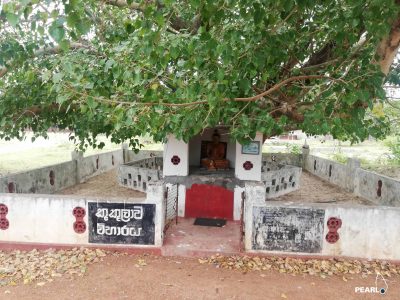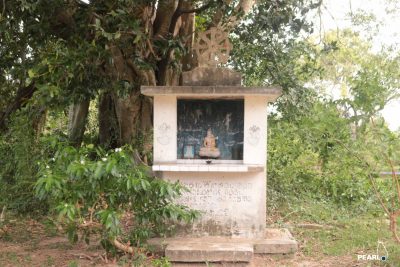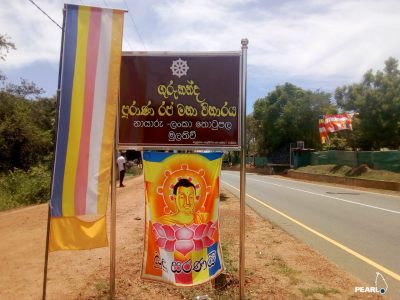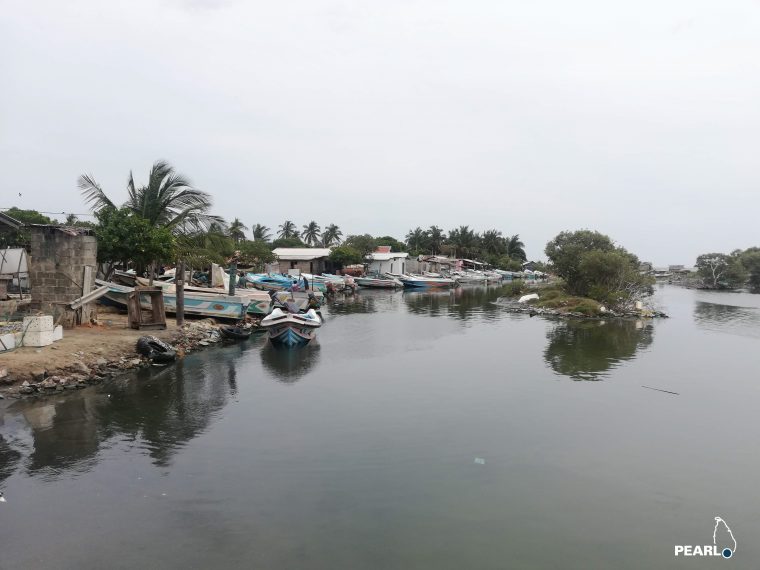by People for Equality and Relief in Lanka (PEARL), October 16, 2019

The south-east of the Mullaithivu District has been a target for state-sponsored Sinhala settlements for decades. As with Pulmoaddai, the Kokkilai region of Mullaithivu lies on the strategically important border between the traditional Tamil homeland’s northern and eastern regions, and as such has been targeted for state-sponsored Sinhala settlements. Much of the region was sparsely populated or not populated at all. In 1948, Prime Minister DS Senanayake “set in motion the process of land settlement in the areas traditionally and politically recognised as the ‘traditional homelands of the Tamil-speaking people’”, which also affected this key area.¹
The Tamil villages of Alampil, Chemmalai, Nayaaru, Kanukerni, Kokkuthoduvaai, Karunaaddukerny and Kokkilai sit on a narrow strip of land, between the Indian Ocean and the lagoons of Kokkilai and Nayaaru, making up the Kokkilai region. The region saw seasonal Sinhala migration from the west coast of the island for decades.² In the past, a few Sinhala families would come and work with and alongside Tamil fishers and return to their west coast villages.³ This occurred without issues for many decades – the migratory practices were accepted by the Tamil community in the early years following independence.⁴

Buddhist Shrine in Kokkilai
However from the 1970s, the government encouraged the Sinhala migrants to settle permanently, promising them land and support.⁵ Furthermore, Sinhalese fishermen from other areas of the country, including owners of larger fleets, also arrived, putting the local Tamil fishermen under pressure and raising tensions between the communities.⁶
Although President Jayawardene in the 80s “pledged not to disturb the ethnic composition of the traditional Tamil homelands”, the structural realities differed.⁷ National Security Minister Lalith Athulathmudali announced in 1984 that the government would solve the “terrorist” problem by settling 200,000 Sinhalese in the North, drawn from groups such as convicted criminals.⁸ In December 1984, in what is termed an act of ethnic cleansing and genocide by the local population,⁹ the government forced all Tamils living in the old Tamil villages of Kokkilai, Kokkuthoduvaai, Karunaaddukerny, Nayaaru, Chemmalai, Kumulamunai and Alampil to leave their homes.¹⁰ The military used their vehicles to make announcements, demanding the Tamils leave within 24 hours.¹¹

Tamil pilgrims at the Neeraviyadi Pillayar Temple, destroyed and moved into the wall of the larger Buddhist temple.
Regular attacks on Tamils by the military followed over the months and years of war, resulting in hundreds of deaths. Tamils were also attacked when they returned to tend to their fields, preventing their resettlement.¹² Tamil militants attacked the Sri Lankan military and Sinhala settlers in response, killing dozens and displacing many more. As of February 1985, 10,000 Tamil and Muslim refugees from the villages of Kokkilai, Karunaaddukerny, Kokkuthoduvaai, Alampil, Nayaaru, Chemmalai, Kumulamunai, Aandankulam, Arumuganthankulam, Murippu and Thennaimaravadi, were in camps in Mullaithivu.¹³ Newspaper reports from the time say they were evicted in order to make room for Sinhala settlers, particularly in Kokkilai and Nayaaru.¹⁴
“The Government is determined that the Sinhalese presence in the northern and eastern provinces, claimed by the Tamils as their historic homelands, shall not be diminished. Indeed they are proposing to increase the proportion of Sinhalese in the area by establishing new settlements of southerners. The new settlers also will be armed and given weapons training. They are also likely to be recruited from prisons. The Tamils, recognizing this as a threat to the integrity of those areas they would like to make independent under the name of Eelam, are determined to fight the proposals.” The Times, 13 February 1985

Buddha Shrine in Koddaikerny
“December 28, 29, 1984: Six Tamil women from Kokuthudavai and Kokilai reached a refugee camp in Mullaitivu complaining that they had been raped by army personnel. There are 21 Tamil refugee camps in the Mullaitivu area […] all chased away from their homes by the security forces.” Tamil Times, February 1985
As southern fishermen and their families were settled on the coast, some of the Sinhala fishermen were given guns used by Tamil farmers for agricultural purposes in the past. This happened on the instructions of the Ministry of Fisheries and the security forces, according to Minister Thondaman’s letter to President Jayawardene in early 1985.¹⁵ Furthermore, the Sinhala fishermen in Nayaaru and Kokkilai were given arms training by the security forces in Negombo. Minister Lalith Athulathmudali visited these settlements on January 15, 1985 and paved the way for further financial and material incentives for those who colonised these regions.¹⁶

Signboard for the Guru Kanda Rajamaha Vihara, built on the site of a Hindu shrine.
Since the end of the armed conflict in 2009, the region has seen increasing tensions between Tamils who returned after displacement and Sinhala settlers, some of whom had by then lived in the area for many years and had solidified their presence. Local Tamils mainly complain about the proliferation of Buddhist structures, the heavy military presence, and the permanent settlement of Sinhalese fisher families by the state on their land. The often illegal occupation of Tamil lands has effectively rendered the social fabric of the space to substantial change. Those Tamils who were resettled back onto their respective lands found themselves having little to no access to basic facilities housing, sanitation, health care and education.¹⁷ Furthermore, religious repression by Sinhala Buddhist monks, with the support of the military, has also fueled anger amidst the population.

Guru Kanda Rajamaha Vihara, with a signboard for the Neeraviyadi Pillayar Hindu temple.
MILITARISATION
BUDDHISIZATION

Guru Kanda Rajamaha Vihara, which was built on the site of a Hindu temple. A military camp is located opposite the new Buddhist complex.
Neeraveeyadi Pillaiyar shrine was an free-standing site of worship frequented by Tamils in the region. Tamils travelling to and from Chemmalai would stop and offer a prayer at the shrine before travelling on.¹⁸ Following the end of the armed conflict, an army camp was established on the site in Neeraveeyadi, Chemmalai, with the subsequent addition of a Buddhist statue. When the displaced Tamils returned to Chemmalai in 2012, they discovered that the Hindu shrine had been occupied. Efforts were made by army leaders to begin the building of the Buddhist temple. The commander of the 593 Brigade authorized the establishment of the Buddhist temple and it named Guru Kanda Rajamaha Vihara.
A Buddhist monk, Kolamba Medhalankara Thero, now resides in the facility originally occupied by the Tamil Hindu shrine.¹⁹ The monk claims that the site was originally home to a large Buddhist complex and that the Tamil shrine was built on top of it. However, a response from the Maritime Pattu Divisional Secretariat to a Right to Information request in 2018 shows that there was no Buddhist temple at the location and no Buddhists lived in this area. The Divisional Secretariat further said that no permission was requested prior to the construction of the Buddhist temple.²⁰

A Buddhist temple under construction on the site of a destroyed Hindu temple, on private Tamil land in Kokkilai.
Court proceedings were initiated and in May 2019 it was held that both religious shrines should equally partake in faith-based activities.²¹ However, this decision was not accepted by the Sinhala Buddhist monk, who brought in Sinhala Buddhist worshippers to protest against this decision in June. In response, hundreds of Tamils gathered from across the Tamil homeland to attend Neerayaavedi’s temple’s “Festival of Resistance” in July this year.²²
Currently the Pillayar shrine occupies a small site on the outside of the Buddhist complex. While Tamils are able to access the location, tensions with the Buddhist monk and the military continue. The local community continues to demand the return of the land.²³
The Arasadi Pillayar Hindu temple, located in Kokkilai, was destroyed during the war. Its site – on land situated between the local hospital and post office – was used to erect a Buddhist temple.²⁴ The owner of the land, T Mannivanathasan, filed a case against the illegal construction, which was upheld in 2015. In a letter to the Buddhist monk behind the illegal construction, the Divisional Secretary called for an end to all construction until the case was resolved. Despite this, construction of the Buddhist temple has continued intermittently.²⁵
SINHALA SETTLEMENTS

Sinhala fishing settlement in Kokkilai
After the forced expulsion of Tamils from Kokkilai in the 80s, Sinhala settlers from the south established further permanent settlements. When the Tamil population returned in 2011, two years after the end of the armed conflict, they found Mukaththuvaram, the area right on the tip of Kokkilai, to be settled entirely by Sinhalese. The Tamil fishermen faced harassment, including the destruction of their equipment, by Sinhala fishermen, monks and the police, when they attempted to engage in their trade.²⁶
In 2018 a court ruled that the land belonging to Tamils must be returned and defeated a claim by Sinhala fishermen for the coastal area in Kokkilai.²⁷ Despite the court order, the Mahaweli Authority and the Housing Development Authority, which both have more power than the local authorities, continued to issue permits and allocate housing schemes to Sinhala fisher families. Local Tamil politicians, including TNA MP Shanthi Sriskandarajah and former NPC Councillor T Ravikaran have vehemently opposed these moves.²⁸ Meanwhile Sinhala Buddhist monks continue to call for the Sinhalisation of the area, as Tamils continue to block government moves to grab further land for settlements.²⁹
According to local officials, around 500 Sinhala families are now settled in this area. While Kokkilai Muhaththuvaram is the largest Sinhala settlement, further permanent settlements exist along the coast, including at Naayaru and Kokkuthoduvaai. However seasonal migration also still occurs.³⁰
The Kokkilai region has been contested for decades. While the seasonal migration of Sinhala fisher families seems to have occurred without many problems pre- and post-independence, the increasingly oppressive policies by the state, including colonisation schemes and violence against Tamils have made this area one of the most disputed regions in the North-East. The Sinhala fisher families are largely recent arrivals but also include those who have engaged in fisheries in this area for decades. From forced expulsion and massacres by the Sri Lankan armed forces against Tamils in the 80s, to the current occupation of religious sites, the Buddhisization of the area and ongoing land grabs, the Sri Lankan state has maintained its project of Sinhalising this region – which, if successful, would drive a wedge between the contiguous Tamil-speaking areas, traditionally claimed as the Tamil homeland. However the local Tamil community has repeatedly demonstrated their readiness to resist and protest these actions. The urgency of their call to halt Sinhalisation efforts must be heeded. Together with neighbouring Pulmoaddai, this region is arguably the most strategically important and economically viable area for the Tamil-speaking people. The pressure of Sinhalisation is felt acutely here. Without a meaningful resolution to Tamil grievances, one that also considers the future of those Sinhala settler families, the potential for further conflict continues to grow.
Footnotes
- The Breakup of Sri Lanka: Tamil-Sinhalese-Tamil conflict; A Jeyaratnam Wilson, 1989 (p 37)
- PEARL Interview with K Ravikaran, September 2019
- PEARL Interview with K Ravikaran, September 2019
- “Land in the Northern Province”; B Fonseka, M Rahim; Centre for Policy Alternatives; 2011
- “Genocide against the Tamil People: STATE AIDED SINHALA COLONISATION”; International Human Rights Association Bremen – People’s Tribunal Sri Lanka, 2013; (accessed at http://www.ptsrilanka.org/wp-content/uploads/2017/04/state_aided_sinhala_colonisation_en.pdf);
- Tamil Times, December 1984
- The Breakup of Sri Lanka: Tamil-Sinhalese-Tamil conflict; A Jeyaratnam Wilson, 1989
- “Mahaveli System L: The Weli Oya Project And The Declaration Of War Against Tamil Civilians”; Rajan Hoole, Colombo Telegraph, 2014; (accessed at https://www.colombotelegraph.com/index.php/mahaveli-system-l-the-weli-oya-project-and-the-declaration-of-war-against-tamil-civilians/)
- PEARL Interview, July 2019
- “Mahaveli System L: The Weli Oya Project And The Declaration Of War Against Tamil Civilians”; Rajan Hoole, Colombo Telegraph, 2014; (accessed at https://www.colombotelegraph.com/index.php/mahaveli-system-l-the-weli-oya-project-and-the-declaration-of-war-against-tamil-civilians/)
- “Special Report 5”; UTHR-J, 1993 (accessed at http://www.uthr.org/SpecialReports/spreport5.htm); https://jaffnazone.com/news/2684
- S Thondaman – March 1985
- Tamil Times, March 1985; The Times (UK), 13 February 1985;
- Ibid
- S Thondaman – March 1985
- Tamil Times, March 1985
- “Situation in North-Eastern Sri Lanka: A series of serious concerns”; MA Sumanthiran, 2011 (accessed at http://dbsjeyaraj.com/dbsj/archives/2759);
- “நீராவியடி பிள்ளையார்” [Video]; IBC Tamil, 2019 (accessed at https://www.youtube.com/watch?v=2dpI2bFzq84)
- “Occupying Colombo schemes Sinhala Buddhist settlement in Chemmalai-East, Vanni”; TamilNet, 2019 (accessed at https://www.tamilnet.com/art.html?catid=79&artid=39477);
- “Occupying Colombo schemes Sinhala Buddhist settlement in Chemmalai-East, Vanni”; TamilNet, 2019 (accessed at https://www.tamilnet.com/art.html?catid=79&artid=39477);
- ‘Buddhist monk files High Court appeal against Mullaitivu Tamil temple”; Tamil Guardian, 2019 (accessed at https://www.tamilguardian.com/content/buddhist-monk-files-high-court-appeal-against-mullaitivu-tamil-temple)
- “Hundreds attend Neeraviyadi temple’s pongal ‘festival of resistance’”; Tamil Guardian, 2019 (accessed at https://www.tamilguardian.com/content/hundreds-attend-neeraviyadi-temples-pongal-festival-resistance);
- PEARL Interviews, July-September 2019;
- “Situation in North-Eastern Sri Lanka: A series of serious concerns”; MA Sumanthiran, 2011 (accessed at http://dbsjeyaraj.com/dbsj/archives/2759);
- “Buddhist monks oversee vihara construction in Mullaitivu”, Tamil Guardian, 2016; (accesssed at https://www.tamilguardian.com/content/buddhist-monks-oversee-vihara-construction-mullaitivu); “Kokkilai Buddhist temple issue”, IBC Tamil , 2016; (accessed at https://www.youtube.com/watch?v=9IBCv5chFrs);
- “Sinhala Buddhist monks and Sri Lankan police threaten Tamil fishermen”, Tamil Guardian, 2016; (accessed at https://www.tamilguardian.com/content/sinhala-buddhist-monks-and-sri-lankan-police-threaten-tamil-fishermen?articleid=22326); “Braving threats, Tamil fishermen return to Kokkilai”, Tamil Guardian, 2016; (accessed at https://www.tamilguardian.com/content/braving-threats-tamil-fishermen-return-kokkilai);
- “Mullaitivu court rules against Fisheries Department and declares contested coastal land belongs to Tamil fishermen”, Tamil Guardian, 2018; (accessed at https://www.tamilguardian.com/content/mullaitivu-court-rules-against-fisheries-department-and-declares-contested-coastal-land)
- “Tamil politicians object to Sinhalese housing scheme in Kokkilai”, Tamil Guardian, May 2019; (accessed at https://www.tamilguardian.com/content/tamil-politicians-object-sinhalese-housing-scheme-kokkilai); “Mullai GA gives in to pressure from top, allocates lands to Sinhala colonists”, TamilNet, May 2019; (accessed at https://www.tamilnet.com/art.html?catid=13&artid=39446); “Mahaweli Authority issues land permits to Sinhalese settlers in Mullaitivu, defying court order”, Tamil Guardian, July 2018; (accessed at https://www.tamilguardian.com/content/mahaweli-authority-issues-land-permits-sinhalese-settlers-mullaitivu-defying-court-order);
- “Sinhala Buddhist monk calls for continued militarisation and Sinhalisation in Mullaitivu”, Tamil Guardian, January 2019; (accessed at https://www.tamilguardian.com/content/sinhala-buddhist-monk-calls-continued-militarisation-and-sinhalisa

People for Equality and Relief in Lanka (PEARL) is 501(c)3 non-profit organization advocating for justice and self-determination for the Tamil people in the North-East of Sri Lanka.





